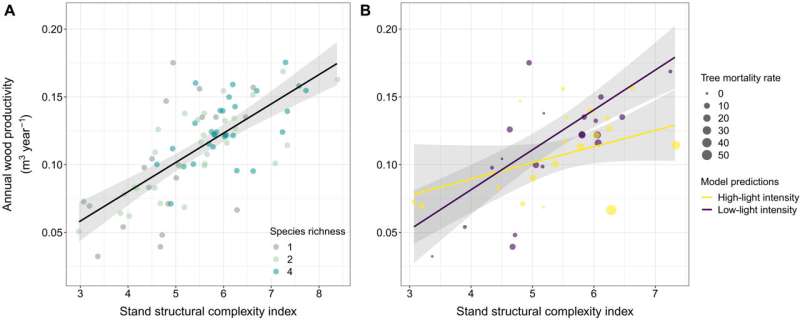This article has been reviewed according to Science X's editorial process and policies. Editors have highlighted the following attributes while ensuring the content's credibility:
fact-checked
peer-reviewed publication
trusted source
proofread
Forest biodiversity: Mixed forests are more productive when they are structurally complex

The richer forests are in different tree species, the faster the trees grow and the more CO2 they can absorb. A joint study by TU Dresden, Leuphana University Lüneburg, Martin Luther University Halle-Wittenberg, University of Leipzig, University of Montpellier and the German Center for Integrative Biodiversity Research (iDiv) Halle-Jena-Leipzig sheds some light on the mechanisms behind this. The results have now been published in Science Advances.
If many different tree species all grow together in a specific area, it has a positive effect on their growth and, as a result, on timber production—this has already been confirmed by a number of other studies. The greater the diversity of tree species in a forest, the more complex the structures. The species do not only grow to different heights in a given period and have very differently developed canopies, they also have individual demands for light, water and nutrients. So far, it has been unclear how structural complexity is related to productivity and which mechanisms are at work in an area of mixed tree species.
Near the town of Bad Lauchstädt in southern Saxony-Anhalt, the MyDiv tree diversity experiment was established in the spring of 2015: A total of 140 saplings were planted in 80 plots of 121 m2 each (11 m x 11 m). There are a total of 10 native deciduous tree species in different combinations: as monocultures, or with a mixture of two or even four different tree species.
Over the past two years, researchers investigated the importance of the structural complexity of the plots for productivity. In addition to the direct measurement of tree height and trunk diameter to calculate the wood volume of the trees, terrestrial laser scanning was used to calculate an index of the three-dimensional structural complexity for each plot.
The results show that it is not species diversity alone that makes for better tree growth, but also the associated structural complexity. Structurally complex communities were almost twice as productive as their structurally simple counterparts. A mix of tree species that require a lot of light paired with shade-tolerant species proved to be particularly effective.
A unique feature of the MyDiv experiment is that the two main types of mycorrhiza—arbuscular mycorrhiza and ectomycorrhiza—are each represented by five tree species. Mycorrhiza is the term used to describe the symbiotic relationship between fungi and plants, in which the mycelium of the fungus is connected to a tree root, for example, and nutrients are exchanged for the benefit of both partners.
This allowed the scientists to investigate not only the influence of above-ground structures, but also what happens below the soil. It turned out that a mix of trees with different types of mycorrhiza had no effect on tree growth.
The study provides valuable information for reforestation projects and shows that the right composition of tree species can ensure significantly faster tree growth. This is all the more important because trees are effective carbon stores, and reforestation is considered an important tool in the effort to combat climate change.
More information: Tama Ray et al, Tree diversity increases productivity through enhancing structural complexity across mycorrhizal types, Science Advances (2023). DOI: 10.1126/sciadv.adi2362
Journal information: Science Advances
Provided by Dresden University of Technology


















